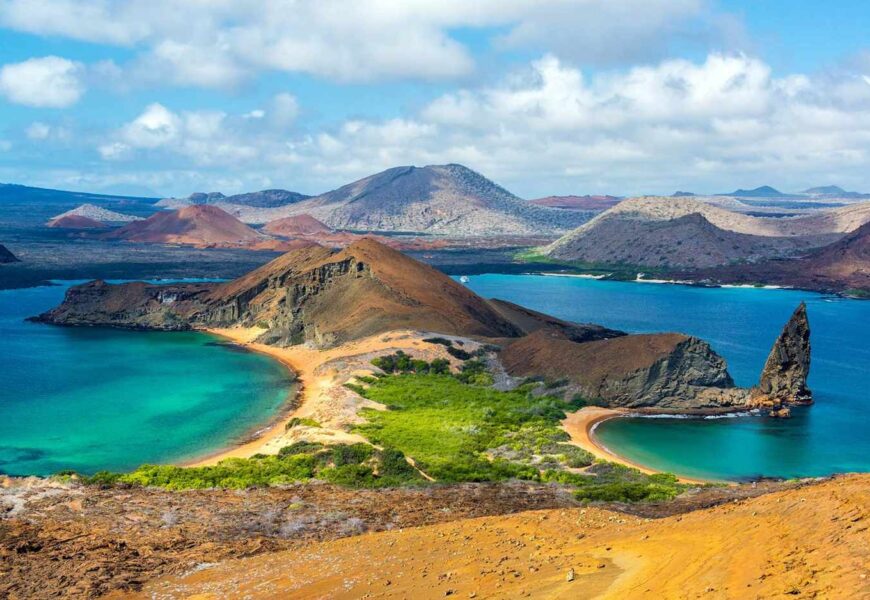The Galápagos Islands, located about 600 miles off the coast of Ecuador, are a pristine archipelago renowned for their unique wildlife, stunning landscapes, and significant role in the history of science. Famous for inspiring Charles Darwin’s theory of evolution, the Galápagos continue to captivate visitors with their natural beauty and biodiversity. Here’s an introduction to the Galápagos Islands, highlighting what makes them a must-visit destination.
A Living Laboratory of Evolution
The Galápagos Islands are often referred to as a “living laboratory of evolution.” Comprising 13 major islands, six smaller islands, and over 100 islets and rocks, the archipelago offers a wide range of habitats that support a diverse array of species. The isolation of these islands has led to the evolution of unique flora and fauna found nowhere else on Earth.
Charles Darwin’s visit to the Galápagos in 1835 aboard the HMS Beagle was a pivotal moment in the development of his theory of natural selection. Observing the variations in species from island to island, such as the famous finches with different beak shapes adapted to their specific diets, Darwin gathered crucial evidence that would later shape his groundbreaking work, “On the Origin of Species.”
Unique Wildlife
The wildlife of the Galápagos Islands is extraordinarily diverse and remarkably unafraid of humans, offering an unparalleled opportunity for close encounters with animals. Here are some of the most iconic species you can expect to see:
Giant Tortoises
The Galápagos giant tortoises are perhaps the most emblematic animals of the archipelago. These gentle giants can live for over a century and weigh up to 500 pounds. Each island hosts its own subspecies of tortoise, with distinct shell shapes and sizes.
Marine Iguanas
Unique to the Galápagos, marine iguanas are the only sea-going lizards in the world. These reptiles have adapted to their environment by developing the ability to forage for algae underwater. Watching them bask on rocky shores or swim gracefully in the ocean is a highlight for many visitors.
Blue-Footed Boobies
The striking blue-footed booby is another iconic species of the Galápagos. These seabirds are known for their bright blue feet and elaborate courtship dances. They can be seen nesting on rocky shores and diving into the ocean to catch fish.
Galápagos Penguins
The Galápagos penguin is the only penguin species found north of the equator. These small penguins have adapted to the warm climate by seeking shade and cooling off in the waters around the islands. They are a rare and delightful sight for visitors.
Other Notable Species
The Galápagos are also home to other fascinating species, such as the flightless cormorant, Galápagos hawk, lava lizards, and a variety of finches and mockingbirds. The marine life is equally impressive, with species like hammerhead sharks, manta rays, sea lions, and the endangered green sea turtle.
Diverse Ecosystems and Landscapes
The Galápagos Islands feature a wide range of ecosystems, from lush highland forests and arid lowlands to volcanic landscapes and vibrant coral reefs. Each island offers unique landscapes and habitats, contributing to the overall biodiversity of the archipelago.
Volcanic Landscapes
The volcanic origin of the Galápagos is evident in its dramatic landscapes. The islands are dotted with active and dormant volcanoes, lava fields, and craters. Isabela Island, the largest in the archipelago, is home to several active volcanoes, including Sierra Negra, which boasts one of the largest volcanic craters in the world.
Beaches and Coastal Areas
The Galápagos are also famous for their beautiful beaches, ranging from white sandy shores to black lava beaches. Tortuga Bay on Santa Cruz Island and Gardner Bay on Española Island are renowned for their pristine beauty and abundant wildlife, including sea turtles, marine iguanas, and sea lions.
Conservation Efforts
The Galápagos Islands are a UNESCO World Heritage Site and a protected national park, with strict regulations in place to preserve their unique ecosystems and wildlife. Conservation efforts focus on controlling invasive species, protecting native habitats, and conducting scientific research to support ongoing preservation.
Visitors to the Galápagos are encouraged to follow responsible tourism practices, such as staying on designated trails, respecting wildlife, and minimizing environmental impact. Guided tours led by certified naturalists help educate visitors about the importance of conservation and the unique challenges facing the islands.
Activities and Experiences
The Galápagos Islands offer a range of activities that allow visitors to explore and appreciate their natural wonders. Here are some of the top experiences:
Snorkeling and Diving
The underwater world of the Galápagos is just as spectacular as its terrestrial environment. Snorkeling and diving opportunities abound, with vibrant coral reefs, marine life, and underwater volcanic formations. Popular dive sites include Darwin and Wolf Islands, where divers can encounter schools of hammerhead sharks, whale sharks, and rays.
Hiking and Wildlife Viewing
Numerous hiking trails across the islands offer opportunities to explore diverse landscapes and observe wildlife. Trails like the Sierra Negra Volcano hike on Isabela Island and the Punta Suárez trail on Española Island provide breathtaking views and encounters with unique species.
Kayaking and Paddleboarding
For a more intimate exploration of the coastal areas, kayaking and paddleboarding are excellent options. These activities allow visitors to navigate through mangrove forests, explore hidden coves, and get up close to marine wildlife in a serene setting.
Planning Your Visit
When planning a trip to the Galápagos, it’s important to consider the best time to visit and the logistics involved. The islands can be visited year-round, but the climate and wildlife activity vary with the seasons.
The warm season (December to May) offers warmer water temperatures, calmer seas, and vibrant vegetation. This is also the best time for snorkeling and diving. The cool season (June to November) brings cooler water temperatures, nutrient-rich currents, and increased marine life activity.
Most visitors arrive by plane from mainland Ecuador, typically from Quito or Guayaquil, and then embark on guided tours or cruises to explore the islands. Booking in advance is recommended, especially during peak travel seasons.
Conclusion
The Galápagos Islands are a unique and enchanting destination that offers an unparalleled opportunity to experience nature’s wonders. From its diverse wildlife and stunning landscapes to its rich scientific history and ongoing conservation efforts, the Galápagos continue to inspire and amaze all who visit. Whether you’re an avid nature lover, a curious traveler, or a history buff, a trip to the Galápagos Islands promises an unforgettable adventure in one of the world’s most extraordinary places.









